Maxim panels are gaining traction in Australia as a superior solution for optimising solar panels in shaded conditions. But does Maxim really work? In a previous blog, I explained why I think Maxim optimisers are the closest thing to shade proof solar, but at that point, I had not performed any testing myself. It’s been six months since we installed our first Maxim integrated panels and around five months since I started running comparative testing of Maxim on my warehouse roof. This post will reveal the results of my testing and the complications I had along the way.
Update: June 2019. This post has a lot of technical content explaining the testing I performed, but there has been a lot of water under the bridge since then. If you want to cut to the chase, scroll to the end of the post. I’ll reveal the best solar optimiser in 2019 given not only my initial reseach and testing, but expereince from hundreds of our residential installations.
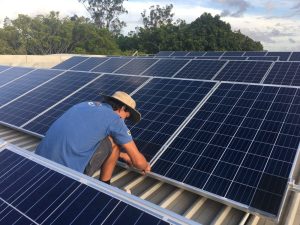
You just can’t.
The comparative test, that was meant to take a week or two, turned into a six-month learning curve, some of which I’ll share in this post.
Let me be clear of my bias. SolarEdge is no longer my friend; Fronius is. I don’t think that deserves an apology or even an explanation but in a breath:
- The Fronius Smart Meter, load control, Solar.Web, reliability, in-built DC isolator, Austrian built.
- SolarEdge legal threats
The original test was set up as follows:
So when I had the systems running over the Christmas break and SolarEdge was continually outperforming Fronius Maxim, I was in denial. The Maxim/Fronius system was running about five per cent worse in unshaded conditions and only equal to SolarEdge when individual cell strings were shaded. So although Maxim was not affected so badly by shade, something was happening to make Maxim panels run worse than SolarEdge in non-shaded conditions. “Maxim is a farce,” I thought.
I tested and retested. I checked the panel flash-test data. It was comparable. I spoke regularly with SolarEdge, Fronius, Maxim and Jinko to try to nut out the problem. All companies showed a vested interest in my testing and spent time with me trying to make sense of my results. I switched my whole current kWh meters around, adjusted DC cable lengths and ensured both inverters were on the same AC voltage reference. One day in frustration I disconnected and reconnected the SolarEdge inverter under load. Don’t try that at home. The inverter let the smoke out and I didn’t catch it. Aaaaargh! It was after this I wrote a curt email to my new “friends” at Maxim an email advising them we were no longer friends and I wanted a refund.
“Maxim is a farce,” I thought.
The next day I thought again and set up the third test on my warehouse roof -as a control:
With all 3 systems running together, I discovered my new Canadian/Fronius panels were running equal to the Maxim/Fronius but still five per cent worse than SolarEdge system.
I then added external SolarEdge optimizers to the standard Canadian panels and switched them over to my SolarEdge inverter. Waddayaknow, they were running five per cent better than Fronius/Maxim. It was clearly not the fault of Maxim. Either SolarEdge was boosting the performance of the panels, or Fronius was hindering. Either way, it was not looking good for Fronius. I called SolarEdge who claimed that, at most, I would see a one per cent increase in unshaded conditions due to mismatch. However, with new, clean, unshaded panels, SolarEdge probably wasn’t boosting the performance of the panels at all. By process of elimination, I had to blame Fronius.
Maxim’s input
I arranged a tele-conference with Maxim in China and in the USA. Daniel from Maxim honed in on the apparent problem. I only have a string of 8 panels on the Fronius 5kW inverter. My string voltage was dropping below the Fronius MPPT optimal range with the high summer temperatures. I pulled out the spec and at went downstairs to read the actual reading of the inverter. “You idiot,” I said out loud to myself. But at least I knew how to solve the problem. I knew the voltage had to be over 240 volts to get the best performance out of the inverter, but surely being a tad under 240v wasn’t going to affect the efficiency by five per cent?! If this is the case, then Fronius has some serious design restrictions and SolarEdge may have won the contest!
Is Fronius to blame?
I called Rod from Fronius.
“Mr Maxim, what’s happenin’,”
answered Rod. He’s always happy that bloke. I should get a job with Fronius, then I’d be happy too.
“Rod, I think I’ve found the problem. If my string voltage is under 240 volts DC, how much power do you think I will lose? Five per cent?”
Ah really M.C? Nah, that doesn’t add up. You’re not going to get a five per cent loss because you’re just under our optimal MPPT voltage range. Hey, one of our Engineers will be over from Fronius in Austria in a few weeks and we’re coming up to Brisbane. We’ll drop into your office and see if we can’t work it out. Have you met Keisha?
A visit from Fronius.

We talked about the Fronius roadmap and the future of batteries. But I was keen to get one thing sorted. What was wrong with my Fronius/ Maxim system?! If we are losing five per cent in performance because we are under the optimal MPPT voltage, then Fronius has some serious design restrictions.
Rod came prepared. “We have a power ratio problem,” said Rod. We looked over the Fronius efficiency data charts. The reason my system was underperforming was simply because I was running 2.12kW of panels on a 5kW inverter. The inverter runs better with higher power input.
Facepalm.We never sell the True Value Solar style “2kw of panels with a huge upgradable 5kw inverter”. However, I had naively figured that because I ran both inverters with the same setup, any insignificant losses would occur on both Fronius and SolarEdge. Seems I was wrong. There were a couple of ways to test, but the quickest was to throw another 8 panels on each system.
A Maxim retest
I redesigned the systems with 16 panels on each string. This increased the voltage and the power in both systems.
Annnnnd…..
It worked. Who’d a thunk? Finally, Fronius/Maxim was performing about as well as SolarEdge in unshaded conditions. Fronius seemed to work worse in low light conditions when the power was sitting below 1000 watts, but better in the middle of the day with full power. Over a 7 day period, SolarEdge and Maxim / Fronius were performing almost identically.
Remember I only installed 4.2kW of panels, so if our common 6.5kW were installed on each system, Fronius may have marginally outperformed. But we are splitting hairs.
Fronius/Maxim VS SolarEdge shade test
After four months of testing, I could finally perform my comparative shade test.
I performed different shade tests over a number of weeks trying to gauge the difference in production between Maxim and SolarEdge. The test was made by shading multiple cells on both systems and reading the results after about 24 hours. It’s hard to know how to quantify the increase in performance, so I have broken it down to it’s simplest form.
For every cell that was shaded (in one cell string only), Maxim ran 0.3% to 0.4% better than SolarEdge.
This test was relatively consistent if I shaded 4 cells or 40 cells on the one cell string and in multiple panels across both systems.
To try and put an actual value on this any given roof would be like counting hairs on your head.
- First, my test used fly screen for consistency of shading. How accurately represents shading compared to tree shading is yet unknown.
- Second, try counting how many cells you would have shaded in a non-uniform manner across your panels, across different times of the day, and different months of the year.
The point is that I have proven the claim. A Maxim/ Fronius system (designed correctly) will give higher output in scattered shade conditions than SolarEdge. With 32 cells shaded, I measured that maxim had an increase in performance of more than 10 percent over a 3 day period.
With 32 cells shaded, I measured that maxim had an increase in performance of more than 10 percent over a 3 day period.
Field experience issues
In total, we have installed 27 systems with Maxim panels. As subjective as this next statement is, Fronius Solar.Web data shows me Maxim is producing well in the various homes we have used them with. Our electricians have also commented on how surprised Maxim is working in scattered shade.
The problem with is, of the 27 systems installed, we have had 13 that have caused issues with TV reception. In every case, it has been in a home where the TV antenna was right on the edge of having bad reception, and Maxim interference pushed it over the edge. To fix these jobs we have just replaced the antenna, but we are looking into getting a filter that will resolve the problem more easily. We’ve also had TV interference issues with SolarEdge and Enphase in the past, though it seems SolarEdge have fixed that issue with their most recent optimisers.
My next test: The new SolarEdge HD Wave
While I’m still a fan of Fronius, I’ve gained further insight into the benefit of SolarEdge.SolarEdge is about to release a new HD Wave inverter, which used a new technology with a higher efficiency. SolarEdge is also releasing products which will compete with Fronius’s load control. Gavin from SolarEdge has generously loaned me one of the only two HD wave inverters in the country to test. In my next test, I’ll compare a 3kW solarEdge HD Wave with a 3kW Fronius Primo.
Update June 2019
Update June 2019: I performed lengthy tests with the SolarEdge inverter and originally wrote a positive review. We installed 130 SolarEdge systems and had ridiculously high failure rates and performance issues. In 2018 I went to SolarEdge Headquarters in Israel to discuss my concerns. I then updated my SolarEdge review outlining the massive issues we have had with SolarEdge. That’s when the SolarEdge legal threats began.
So in 2019, what is the answer to the question: “SolarEdge or Maxim?”
The answer is Tigo optimisers because:
- Maxim has left the Australian market because of issues with TV reception
- SolarEdge have all types of issues that I address in my SolarEdge review.
- Tigo is reliable and flexible. Read my Tigo review.
Moral of the story, it’s one thing to do testing – it’s another to have field experience.
Mark Cavanagh

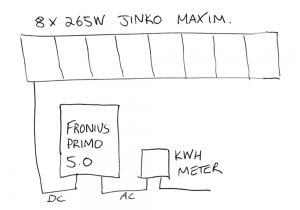
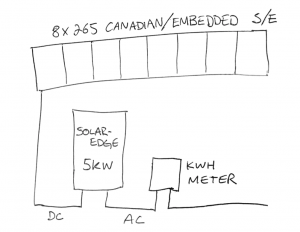
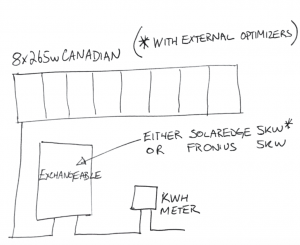
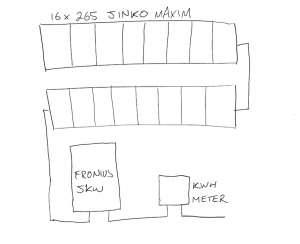
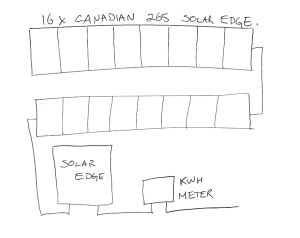
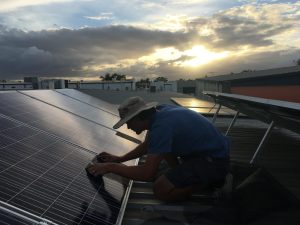

3 Responses
Hi Mark, so nice your youtoube videos and your testing. I am working with solar since almost ever, my father started doing pv off-grid system in 1985. Just a quick question, is it possible to mix maxim-optimized pv modules with non optimized modules in the same string? technically i would say yes, when I look on the maxim datasheet. our austrian supplier kioto/sonnenstromfabrik has got modules with or without maxim otpimizers, we also usually use tigo, but technically i would prefer maxim (just partial where permanent shadow), rest un-optimized.
Hi Reza. Unfortunately Maxim never really took off. I heard they were being installed in some cheaper Chinese panels recently, but not in any quality panels. I’d prefer to get a quality no-Chinese panel with a few Tigos if needed, or with Enphase Microinverters if you have significant shade issues.
Hi Are there any updates on Maxim in Australia in 2020? Do you still believe that it’s one of the best solutions for mitigating shade?